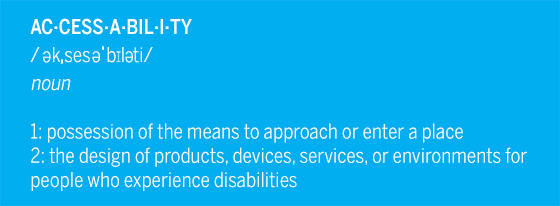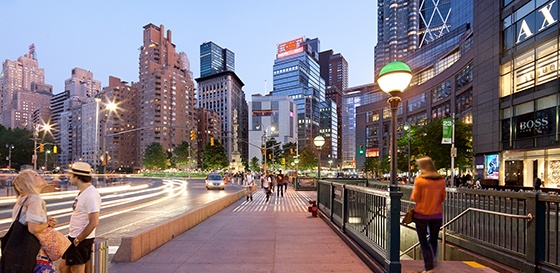Infrastructure Week: Accessability

Over the past week, we have introduced the importance of infrastructure as a vital support system for all urban environments; how resilient design is to ensuring a lasting future for these systems; network-thinking to strengthen connectivity; and how a modern metropolis cannot live and sustainably grow without safe and fast transit infrastructure networks. Each of these points are imperative to the development of urban infrastructure, however, without access to these systems for all people, the point is moot. Access for All – People need transportation to live their daily lives – to get to work, school, recreation, and to access vital medical services. How do we physically approach and move through our built environment?
At the broadest level, accessible design is concerned with designing for diversity and equity. It’s about improving our access, not limiting it. There are accessibility laws which establish requirements and a baseline level of protection for people with disabilities*, but beyond this, an expanded approach examines an environment that can be much more, when we focus our attention on improving function for a large range of people. Accessible design allows a higher quality of life for all people.
How do we accomplish this? Create equitable paths. Make circulation which is simple and intuitive. Ensuring perceptible information. Allow sufficient size and space for Approach and Use.
Within our existing infrastructure and public transportation systems, this can be particularly challenging. There are the physical issues of dealing with environments built before accessibility was of concern; barriers, space availability, and reliability.
Critical, heavily-trafficked stations, built over a century ago, are often still in heavy use today. Such was the case at 59th Street-Columbus Circle station. By threading-the-needle of elevator shafts between these layers of history, infrastructure, and utilities, we can create these accessible paths, both vertically and horizontally, developing important station nodes, providing a sense of place, and facilitating wayfinding for all passengers.
At the new Hudson Yards – 34 Street Station, the path of the Inclined Elevator (the transit system’s first glass-enclosed inclined elevator) runs aligned with the main path of circulation, adjacent to available escalators promoting visual connection and safety and creating an equitable path in travel distance as well as landing at similar levels of the station.
As this 6th annual National Infrastructure Week comes to a close, we’ll continue to apply these principals of Resilience, Connectivity, Constructability, and Accessibility into our existing built environment, future infrastructure, and beyond.
*Accessibility laws, such as the Architectural Barriers Act (1968), Section 504 of The Rehabilitation Act of 1973, the Fair Housing Act Amendments (1988), and the Americans with Disabilities Act (1990).
